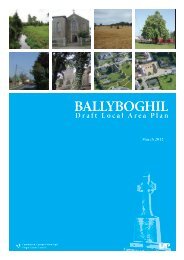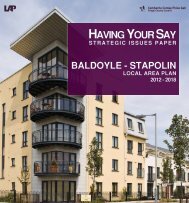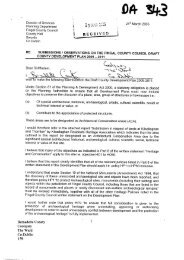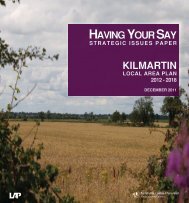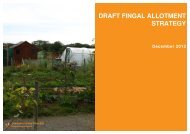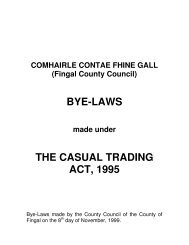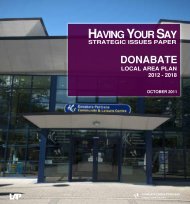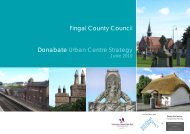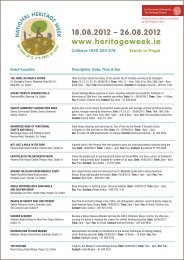Castleknock Urban Centre Strategy - Fingal County Council
Castleknock Urban Centre Strategy - Fingal County Council
Castleknock Urban Centre Strategy - Fingal County Council
Create successful ePaper yourself
Turn your PDF publications into a flip-book with our unique Google optimized e-Paper software.
<strong>Fingal</strong> <strong>County</strong> <strong>Council</strong> Comhairle Contae Fhine Gall<br />
Objective CLK 10<br />
All new development shall sensitively<br />
incorporate the identified<br />
heritage buildings and structures<br />
of <strong>Castleknock</strong>. New use shall be<br />
provided for these structures<br />
which ensure their long term viability.<br />
Objective CLK 11<br />
Car parking shall be provided in<br />
all new development and redevelopment.<br />
The level of car<br />
parking shall be determined by the<br />
Planning Authority.<br />
Objective CLK 12<br />
All new development shall provide<br />
cycle parking at a location that<br />
maximise security and usage.<br />
Objective CLK 13<br />
A parking management strategy<br />
shall be formulated for the Village<br />
to include measures to prevent<br />
unauthorised parking on footpaths<br />
and public areas.<br />
<strong>Castleknock</strong> <strong>Urban</strong> <strong>Centre</strong> <strong>Strategy</strong> 26<br />
proposals for development in the vicinity to have due regard to their<br />
character and presence.<br />
St. Brigids Church is the most prominent and important heritage<br />
feature of the village. Its visual dominance and character are to be<br />
protected with new development enhancing the various vistas towards<br />
the church site.<br />
A design ‘Statement of Character’ for <strong>Castleknock</strong> ACA will be<br />
prepared by <strong>Fingal</strong> <strong>County</strong> <strong>Council</strong> in autumn 2008. This conservation<br />
document will provide detailed advice and policies to guide the<br />
formulation of development proposals and to aid their assessment by<br />
the Planning Authority.<br />
3.7 Car Parking<br />
Car parking should generally be sited within established building lines<br />
in such a manner as to ensure minimal injury to the amenity of<br />
adjoining premises. In the village, parking spaces should be located<br />
behind buildings or underground, to encourage the continuity of<br />
streetscapes. Where parking will be opened to public view, adequate<br />
landscaping and tree planting must be provided to counteract the<br />
appearance of parking areas. It is an objective of the strategy that the<br />
layout of the development is designed to accommodate but not be<br />
dominated by the car. Car parking provision shall be carefully<br />
integrated in terms of layout, surface treatment and screen planting.<br />
Where surface car parking is required, it should be designed to be<br />
overlooked and therefore comply with the principles of passive<br />
surveillance and should not dominate the street frontage. Parking<br />
control is a mechanism available for managing car use and this<br />
should be formulated in a strategic manner by the <strong>Council</strong>.<br />
Cycle parking facilities shall be conveniently located, secure,<br />
adequately lit and weather protected. Cycle parking shall be provided<br />
in tandem with new development to adequately serve new<br />
commercial attractions.




